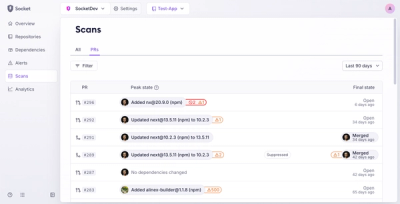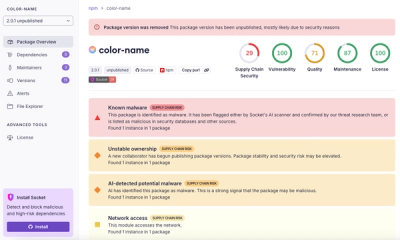
Product
Introducing Pull Request Stories to Help Security Teams Track Supply Chain Risks
Socket’s new Pull Request Stories give security teams clear visibility into dependency risks and outcomes across scanned pull requests.
Python code to process input and output files of HiPIMS flood model. This code follows Google Python Style Guide.
Python version: >=3.6. The main content of this package is also included in a Python API of HiPIMS.
To install hipims_io from command window/terminal:
pip install hipims_io
To install using github repo:
git clone https://github.com/mingxiaodong/hipims_io_python.git
cd hipims_io_python
pip install .
A quick demonstration to setup a HiPIMS input object with a sample DEM:
import hipims_io as hp
obj_in = hp.demo_input() # create an input object and show domain map
A quick demonstration to setup a HiPIMS input object with a data path contaning the following files:
import os
import hipims_io as hp
from hipims_io.demo_functions import get_sample_data
dem_path, _ = get_sample_data(return_path=True) # get the path of sample data
data_path = os.path.dirname(dem_path)
case_folder = os.path.join(os.getcwd(), 'hipims_case') # define a case folder in the current directory
obj_in = hp.InputHipims(case_folder=case_folder, num_of_sections=1,
data_path=data_path) # create input object
obj_in.domain_show() # show domain map
print(obj_in) # show case information
A step-by-step tutorial to setup a HiPIMS input object with sample data:
import os
import numpy as np
import hipims_io as hp
dem_file, model_data, _ = hp.get_sample_data() # get sample data
case_folder = os.path.join(os.getcwd(), 'hipims_case') # define a case folder in the current directory
# create a single-gpu input object
obj_in = hp.InputHipims(dem_data=dem_file, num_of_sections=1, case_folder=case_folder)
# set a initial water depth of 0.5 m
obj_in.set_initial_condition('h0', 0.5)
# set boundary condition
bound_list = model_data['boundary_condition'] # with boundary information
obj_in.set_boundary_condition(bound_list, outline_boundary='fall')
# set rainfall mask and source
rain_source = model_data['rain_source']
obj_in.set_rainfall(rain_mask=0, rain_source=rain_source)
# set manning parameter
manning_array = np.zeros(obj_in.DEM.shape)+0.03 # create an array with the same shape of the DEM array
obj_in.set_grid_parameter(manning=manning_array)
# set monitor positions
gauges_pos = model_data['gauges_pos']
obj_in.set_gauges_position(gauges_pos)
# display model information
obj_in.domain_show() # show domain map
print(obj_in) # print model summary
# write all input files for HiPIMS to the case folder
obj_in.write_input_files()
The domain map will be shown like this:

FAQs
To process input and output files of the HiPIMS model
We found that hipims-io demonstrated a healthy version release cadence and project activity because the last version was released less than a year ago. It has 1 open source maintainer collaborating on the project.
Did you know?

Socket for GitHub automatically highlights issues in each pull request and monitors the health of all your open source dependencies. Discover the contents of your packages and block harmful activity before you install or update your dependencies.

Product
Socket’s new Pull Request Stories give security teams clear visibility into dependency risks and outcomes across scanned pull requests.

Research
/Security News
npm author Qix’s account was compromised, with malicious versions of popular packages like chalk-template, color-convert, and strip-ansi published.

Research
Four npm packages disguised as cryptographic tools steal developer credentials and send them to attacker-controlled Telegram infrastructure.